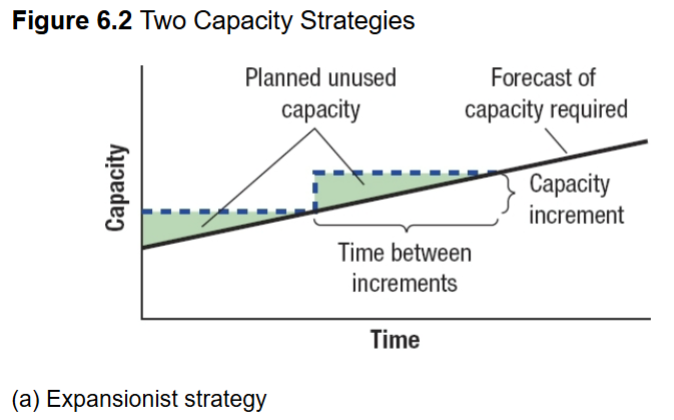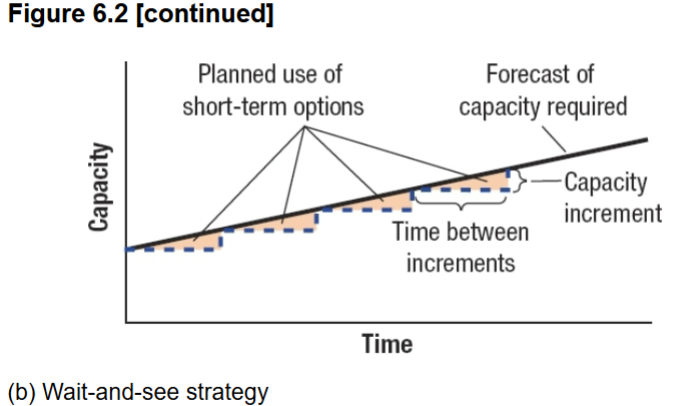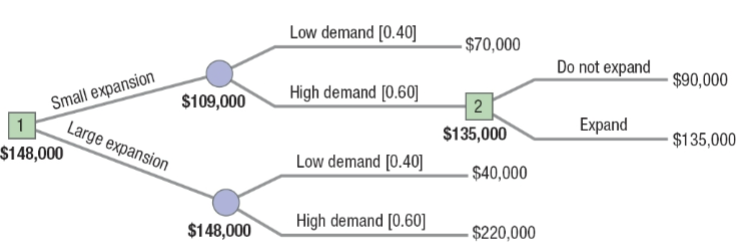Chapter 6 - Capacity Planning
1/18
There's no tags or description
Looks like no tags are added yet.
Name | Mastery | Learn | Test | Matching | Spaced |
|---|
No study sessions yet.
19 Terms
Capacity
The maximum rate of output of a process or a system
Equipment
Space
Employee Skills
Capacity Planning
Economies and diseconomies of scale
Capacity timing and sizing strategies
Systematic approach to capacity decisions
Output Measures of Capacity
Best utilized when applied to individual processes within the firm or when the firm provides a relatively small number of standardized services and products
Input Measures of Capacity
Generally used for low-volume, flexible processes
Utilization
– The degree to which equipment, space, or the
workforce is currently being used
– Measured as the ratio of average output rate to
maximum capacity (expressed as a percentage)

Economies of scale
The average unit cost of a service or good can be reduced by increasing its output rate
Spreading fixed costs
Reducing construction costs
Cutting costs of purchased materials
Finding process advantages
Diseconomies of scale
The average cost per unit increases as the facility’s size increases
Complexity
Loss of focus
Inefficiencies

Sizing Capacity Cushions
The amount of reserve capacity a process uses to handle sudden increases in demand or temporary losses of production capacity
It measures the amount by which the average utilization (in terms of total capacity) falls below 100 percent.
Capacity cushion = 100% − Average Utilization rate (%)
Capacity cushions vary with industry
Capital intensive industries prefer cushions well under 10 percent while the less capital-intensive hotel industry can live with 30 to 40 percent cushion

A Systematic Approach to Long-Term Capacity Decisions
1. Estimate future capacity requirements
2. Identify gaps by comparing requirements with available capacity
3. Develop alternative plans for reducing the gaps
4. Evaluate each alternative, both qualitatively and quantitatively, and make a final choice
Capacity Requirements
What a process’s capacity should be for some future time period to meet the demand of customers (external or internal) given the firm’s desired capacity cushion
Using Output and Input Measures
Step 1: Estimating Capacity Requirements (For one service or product processed at one operation with a one-year time period, the capacity requirement)
Where:
D = demand forecast for the year (number of customers served or units produced)
p = processing time (in hours per customer served or unit produced)
N = total number of hours per year during which the process operates
C = desired capacity cushion (expressed as a percent)
M = Number of machines required

Step 1: Estimating Capacity Requirements Setup times (time required to change a process or an operation from making one service or product to making another may be required if multiple products are produced)
Where:
Q = number of units in each lot (batch)
s = setup time in hours per lot (batch)

Step 2: Capacity Gap
Positive or negative difference between projected capacity requirements (M) and current capacity
Steps 3 and 4 – Develop and Evaluate Alternatives
Base case is to do nothing and suffer the consequences
• Many different alternatives are possible
• Qualitative concerns include uncertainties about demand, competitive reaction, technological change, and cost estimate
• Quantitative concerns may include cash flows and other quantitative measures
Cash flows
the difference between the flow of funds into and out of an organization over a period of time
Tools for capacity planning
Waiting-line models
Simulation
Decision trees
Waiting-line models
Useful in high customer-contact processes
Simulation
Useful when models are too complex for waiting-line analysis
Decision trees
Useful when demand is uncertain and sequential decisions are involved
